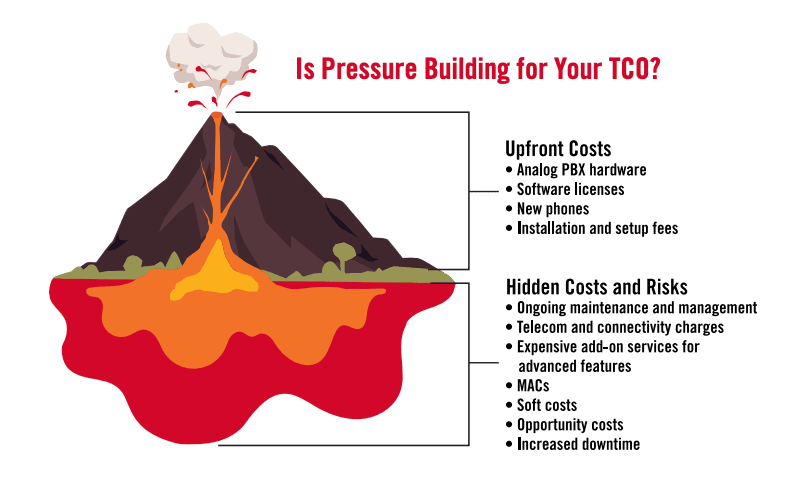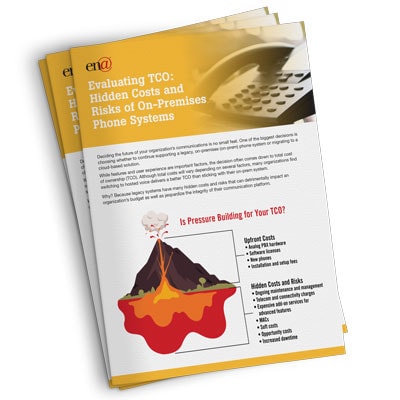Deciding the future of your organization’s communications is no small feat. One of the biggest decisions is choosing whether to continue supporting a legacy, on-premises (on-prem) phone system or migrating to a cloud-based solution.
While features and user experience are important factors, the decision often comes down to total cost of ownership (TCO). Although total costs will vary depending on several factors, many organizations find switching to hosted voice delivers a better TCO than sticking with their on-prem system.
Why? Because legacy systems have many hidden costs and risks that can detrimentally impact an organization’s budget as well as jeopardize the integrity of their communication platform.

1) Large Upfront Capital Expenditures
Large, upfront capital expenditures (capex) required for legacy phone systems can be prohibitive and depreciate over time.
In fact, PCG Telecom & Data Network estimates the average cost is $800-$1,200 per PBX extension. Depending on your organization’s budgeting model and revenue or funding sources, this amount of upfront capital can simply be out of reach.
2) Legacy Phone System Maintenance and Management
After tackling upfront payments and installation fees, be prepared for your IT team to own top-to-bottom system maintenance and management. This will include ongoing expenses like replacement and upgrade parts, firmware updates, server and phone maintenance, security patches, extra software, and more. Also, because legacy systems run on older technology, you run the risk of obsolescence with replacement parts becoming hard or impossible to find.
3) Dedicated IT Time and Talent
There’s no way to get around it – telephony platforms are complex systems requiring voice engineers for efficient and appropriate management. With a premises-based system, you’ll need dedicated, in-house telecom experts who can perform ongoing, day-to-day maintenance, handle implementations and changes, resolve technical issues, manage helpdesk tickets, roll out upgrades, and more – costly and time-consuming tasks for valuable internal IT personnel.
4) Annual Maintenance Contracts
On top of your internal IT resources, most organizations also pay for an annual maintenance contract that costs anywhere from 10-20% of your phone system’s software value per year. That means within 5-10 years, you’ll have paid the value of your entire system in the maintenance contract alone.
Anything outside your agreement terms, which often includes moves, add-ons, and changes (MACs), will cost more every time a technician is required to come on-site or a replacement part for your phone system is needed. Additionally, the time spent scheduling and waiting for outside personnel to fix your system could result in multi-day delays and prolonged system downtime, costing you more money in lost revenue and staff productivity.
5) Telecom Costs
Traditional phone systems require multiple telecom expenses. From direct inward dialing (DIDs) to local, long distance, and 800 calling fees, these expenses must be factored in for an accurate financial comparison.
6) Difficult Scalability
Your phone system needs to be flexible enough to change with your organization; however, opening new offices, moving locations, connecting branches, or adding extensions to legacy phone systems can be extremely cumbersome and cost a small fortune. Sometimes additional expenses for PSTN or similar business exchange lines are required, and more complexity is added if you have multiple phone systems spread across locations with incompatible hardware.
Unless you have a provider or outside consultant, it’s your responsibility to execute the changes without causing system downtime. On the other hand, because on-prem systems rely on future capacity estimations, you run the risk of wasting money through overprovisioned trunks or underutilized hardware if those forecasts are inaccurate.
7) Evolution to UCaaS
Most organizations are moving towards unified communications with integrated mobile calling, messaging, web meetings, and more. While these are technically possible to achieve on-prem, they are not always built-in, requiring investments in stand-alone, à la carte services that are too costly to integrate yourself and will need to be purchased through third parties.
However, if you don’t provide these features, there are soft costs you must consider such as loss of staff productivity and missed opportunities. And to top it off, as legacy systems add more advanced functionality, they require increased support personnel and hours to maintain the complex environment.
8) Risk of Failure and Downtime
While not hard costs, risks are important components that need to weighed and quantified. The average analog PBX system should be replaced every 5-10 years, but it’s not uncommon for organizations to attempt stretching that lifespan out much further. While this can feel cost-effective, the risk for failure grows as hardware ages past its prime.
- Individual components will start failing and replacement parts can be expensive and difficult to find
- Different features will stop working, causing disruptions in company workflows and processes
- Older cables and power supplies can be vulnerable to power surges
- The underlying switchboard and line trunks can fail, causing the entire system to crash
- Even if you’re able to get it working again, a complete reprogramming could be necessary which can take a voice engineer an entire day to accomplish
9) Additional Redundancy
To mitigate the risk of failure, you’ll need to replace hardware proactively and more frequently, as well as add internal site redundancy to your system. How will your system handle calls if equipment is lost in flood, fire, or electrical failure? No matter your strategy, adding in this resiliency will require increased investment.
Cloud Phone Systems – How Do They Stack Up?
A hosted VoIP and unified communications solution like ENA SmartVoice eliminates many of these hidden costs while significantly reducing IT burden.
Minimal Capex
With ENA’s communication solutions, there’s no outlay of capital expenditures and no equipment to buy, install, or maintain outside of handsets, saving you thousands of dollars upfront.
Flat Monthly Rate
Hosted phone solutions actually level the playing field for smaller to medium-sized organizations, enabling them to transition to one predictable, flat monthly operating expense, dedicate cash for revenue-generating solutions, and better allocate capital project management funds.
Reduced Telecom Costs
With a hosted provider like ENA, telecom expenses are reduced as all communications traffic travels over the Internet. Plus, unlimited long distance and local phone lines are included in your package.
Fully Managed, Zero Maintenance Fees
ENA’s voice solutions are fully managed and MACs are also included. We take care of everything in the cloud with proactive maintenance, updates, technical support, and continuous improvements – ensuring you’re always on the latest software and reducing operational expenses.
Scalable
Hosted platforms are built for cost-effective, easy scalability – simply add new phone handsets and purchase an additional service plan when you need to. Administrators can quickly set up new staff by adding phones, making changes, and initiating moves directly from our user-friendly web portal. Only pay for what you need and never worry about adding servers or switches again.
All-in-One Platform
ENA’s voice platform includes packages with combined phone, chat, presence, texting, and video conferencing – enabling you to ditch the services sprawl and simplify with one vendor for all your communication needs.
Reliable
ENA’s highly-secure, carrier-grade voice architecture holds an industry-leading 99.999% uptime and our solutions are 4x more resilient than a single PBX. In the event of an outage or incident, calls can be rerouted and ENA’s mobile app ensures communications can continue over Wi-Fi/4G/LTE.
Productivity and Mobility
Cloud systems are built with the latest UCaaS features and functionality to enhance staff productivity and enable mobile workforces with little technical setup (which your IT team will love).

